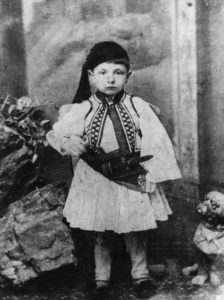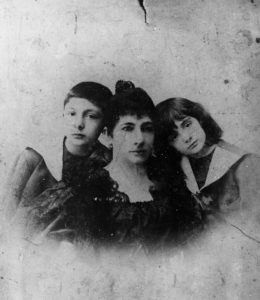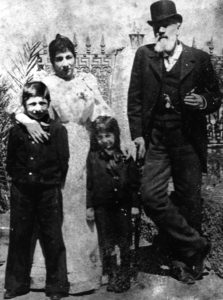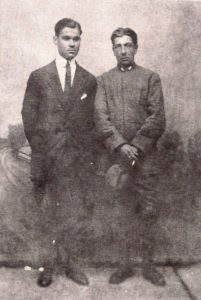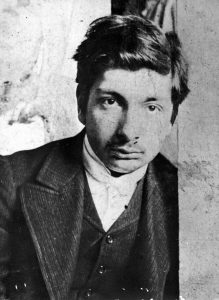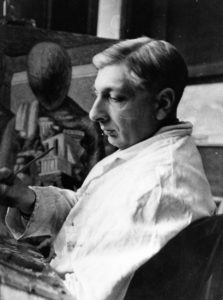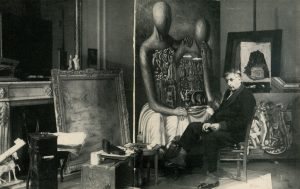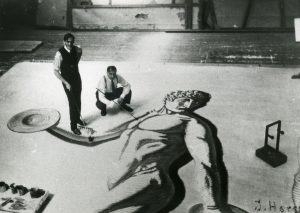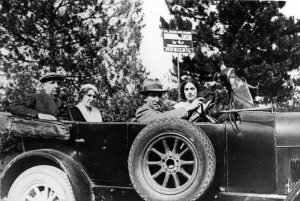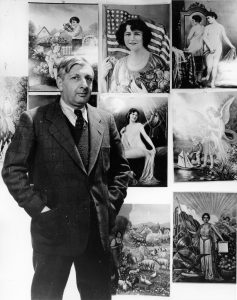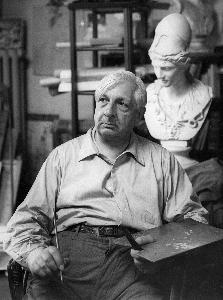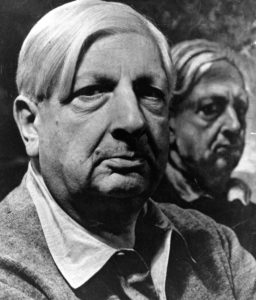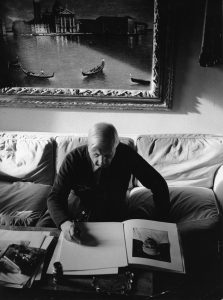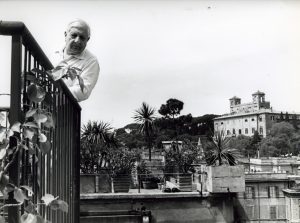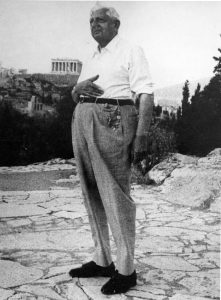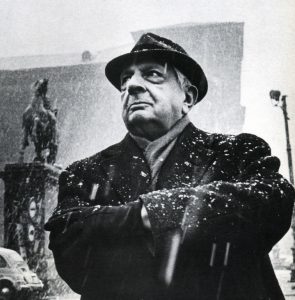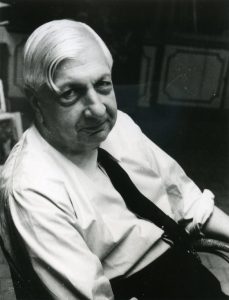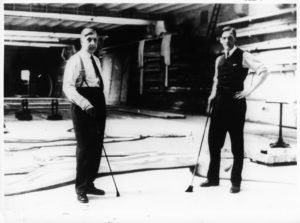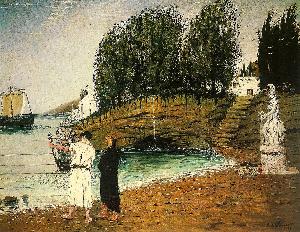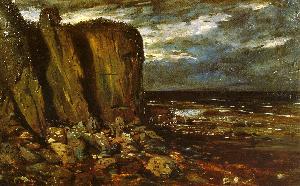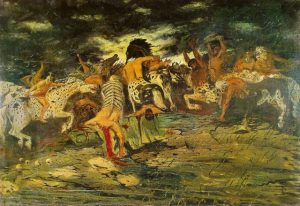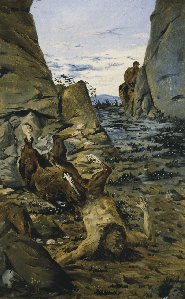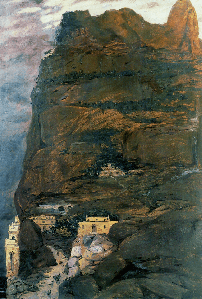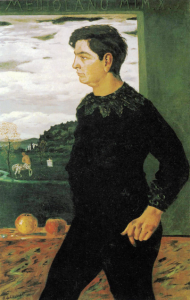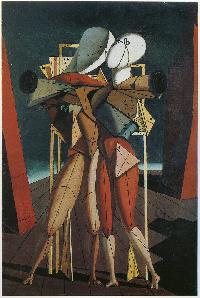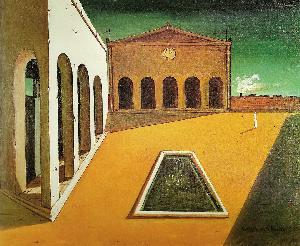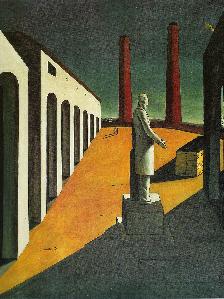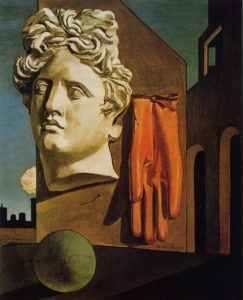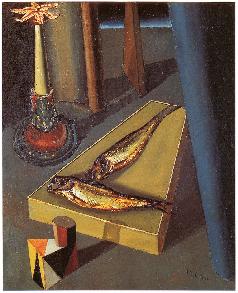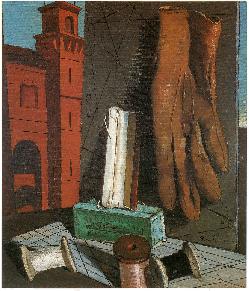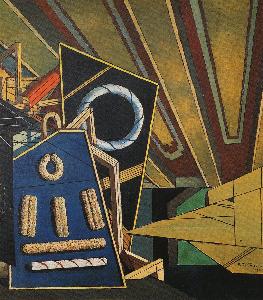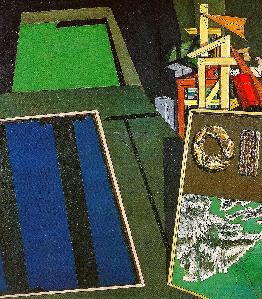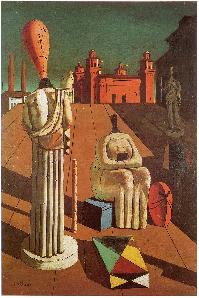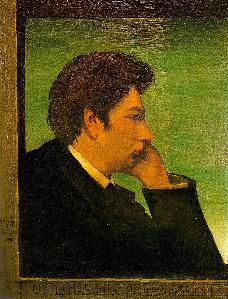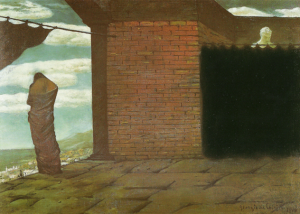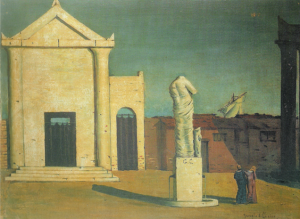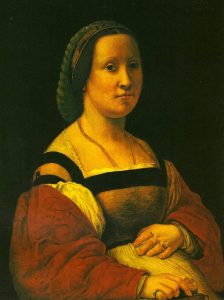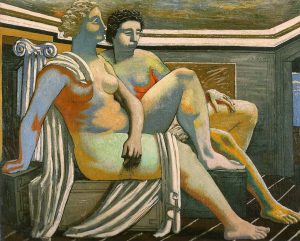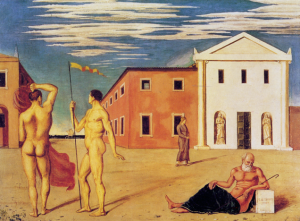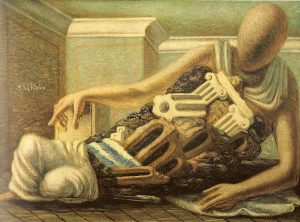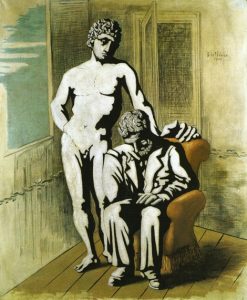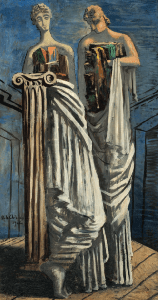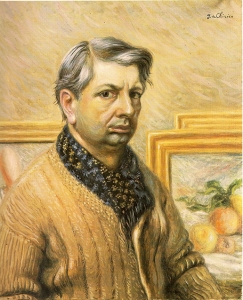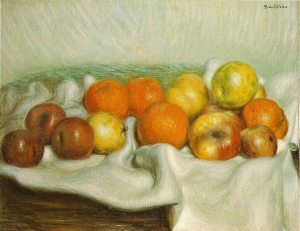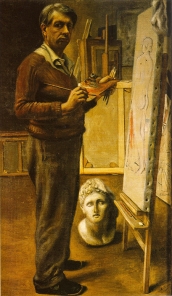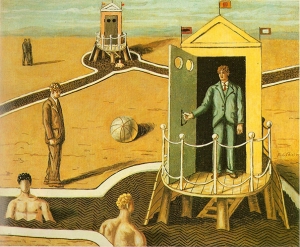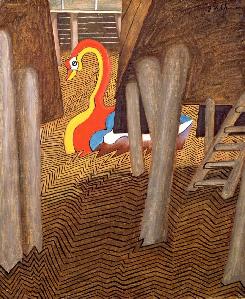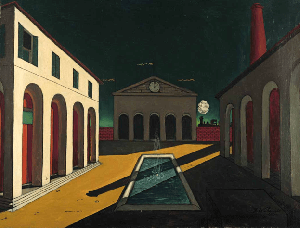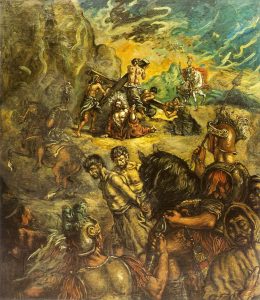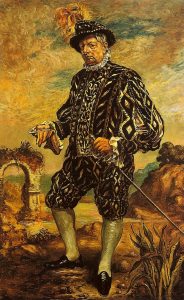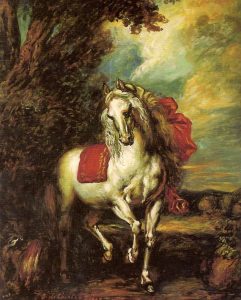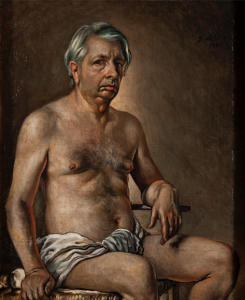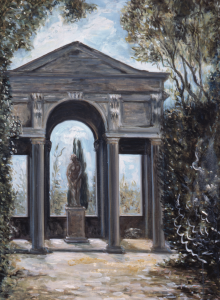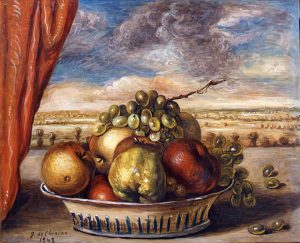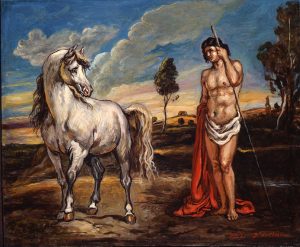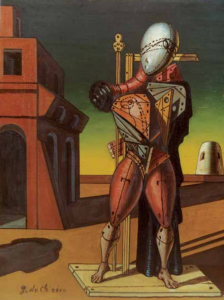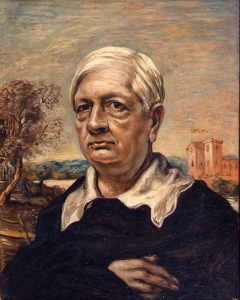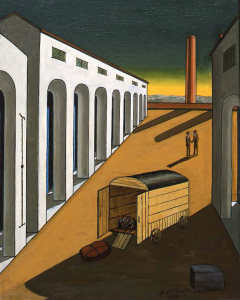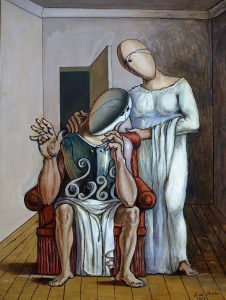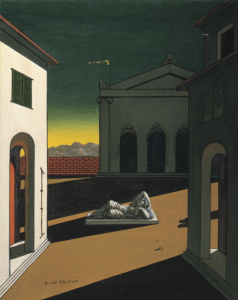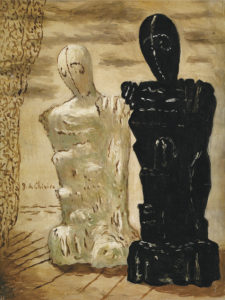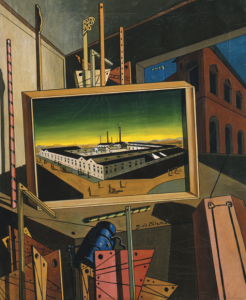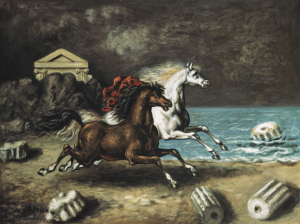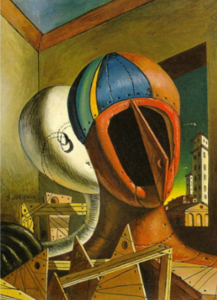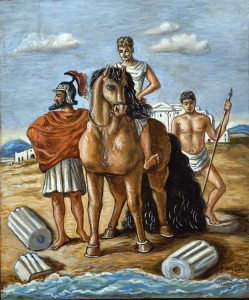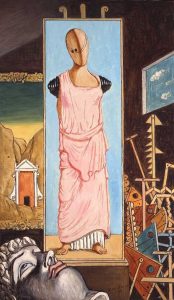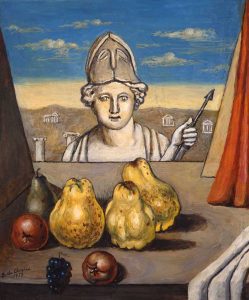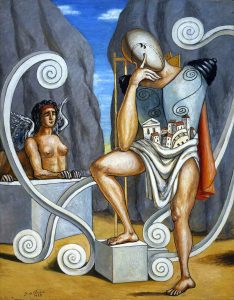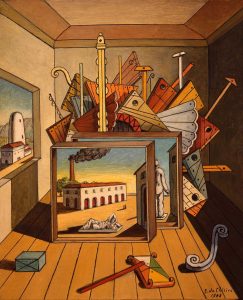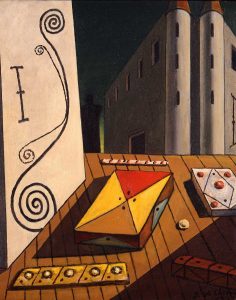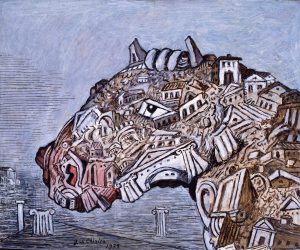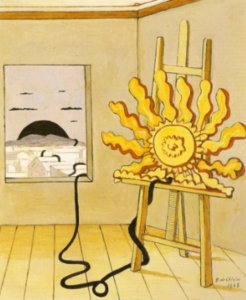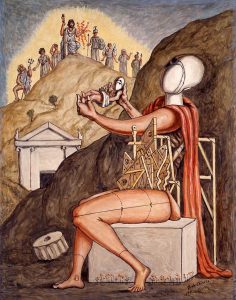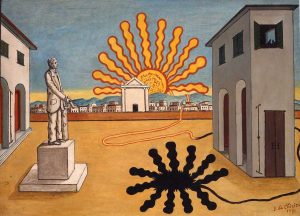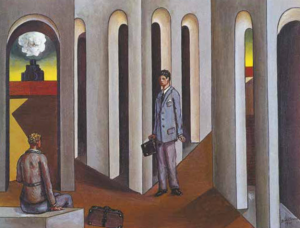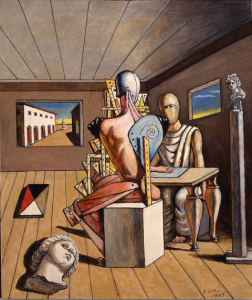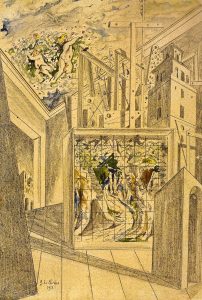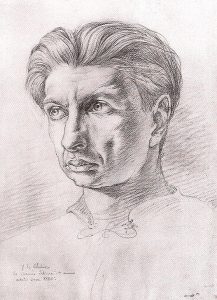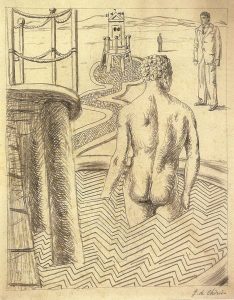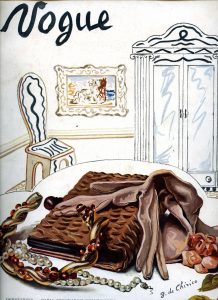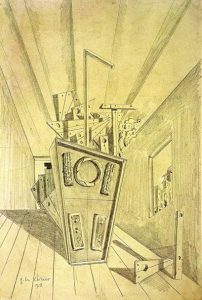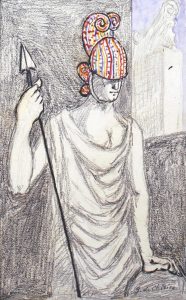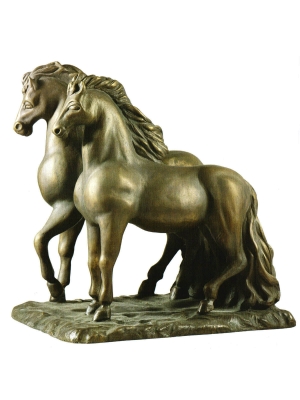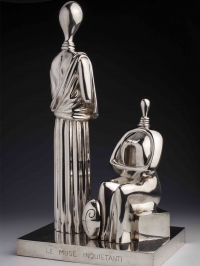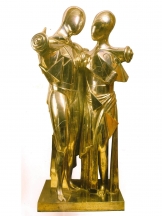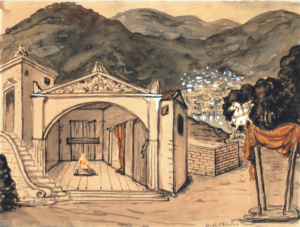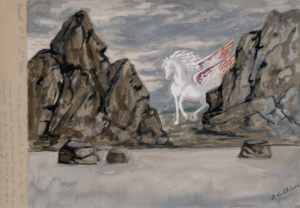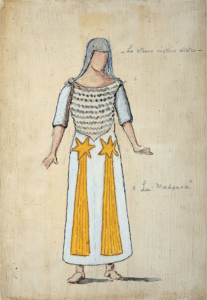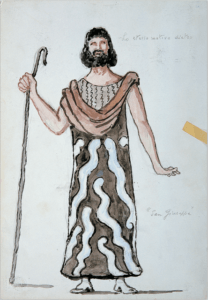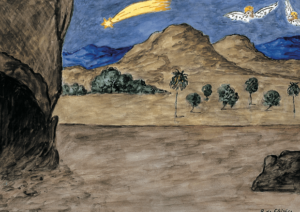Biography
Childhood and education: Greece-Munich-Milano 1888-1909
Giuseppe Maria Alberto Giorgio de Chirico was born on 10 July 1888 in Volos, Greece, to Italian parents. His father Evaristo came from a noble family of Sicilian origin and was a railway engineer in charge of the construction of the Thessaly railway. His mother Gemma Cervetto came from a family of Genovese origin. In 1891, his elder sister Adelaide died. In August, his brother Andrea (who changed his name to Alberto Savinio in 1914) was born in Athens. In 1896, the family returned to Volos where they stayed until 1899 and where Giorgio took his first drawing lessons. They returned to the capital where Giorgio attended the Athens Polytechnic form 1903-1906. After several years of ill health, his father died in May 1905 at the age of 62. In September 1906, his mother decided to leave Greece with her sons. After two short stopovers in Venice and Milan, the family settled in Munich where Giorgio attended the Academy of Fine Arts whilst Andrea studied music. Giorgio studied the art of Arnold Böcklin and Max Klinger, and read the works of Nietzsche, Schopenhauer and Weininger with great interest. In June 1909, he joined his mother and brother in Milan. He painted Böcklin-inspired paintings during this period. He suffered from severe intestinal illness brought about by the death of his father.
Metaphysical Art: Florence-Paris-Ferrara 1910-1918
The Romantic-classical period: Rome 1919-1925
The Second Period in Paris and in Italy: Paris-Milan-Florence 1925-1935
America: New York 1936-1938
In August 1936, he went to New York where he exhibited his recent work at the Julien Levy Gallery. A number of paintings were bought by Albert C. Barnes for his museum as well as by other art collectors. The artist collaborated with magazines such as “Vogue” and “Harper’s Bazaar”. He also executed a mural entitled Petronius and the Modern-day Adonis in Tails for the tailor Scheiner and decorated a wall at Helena Rubinstein’s beauty institute. He designed a dining room for Decorators Picture Gallery, in an initiative in which Picasso and Matisse also participated. In June 1937, he received news from his brother of their mother’s death.
Europe pre and postwar: Milan-Paris-Florence-Rome 1938-1946
Rome at last: Piazza di Spagna 1947-1967
The final years - Metaphsyical Art: Rome 1968-1978
Artwork
Paintings
Paintings 1909-1910
Paintings 1910-1920
Paintings 1920-1930
Paintings 1930-1940
Paintings 1940-1950
Paintings 1950-1968
Paintings 1968-1976 – la Neometafisica
Works on paper
Scultura
Teatro
Written Work
Written Work
Giorgio de Chirico’s prolific literary activity traces the entire arc of his long life and is characterised by a wide variety of genres and styles, ranging from theoretical and critical essays to numerous philosophic studies, polemic articles and reviews, poetry and prose, autobiographies, novels, drama and, of course, correspondence, both personal and work-related. In addition to his first theorisation of Metaphysical Art, his written work focuses on modern art and classical art, as well as on the work of the Great Masters of the past and on contemporary artists. His collected writings also include various treatises on painting technique and on the concept of Theatre. This section presents a list of Giorgio de Chirico’s collected writings and a selection of essays translated into English.
Collected Writings
Collected Writings: 1911-1920
Testi teorici e lirici (Manoscritti Eluard-Picasso) (1911-1915) G. de Chirico, Il meccanismo del pensiero, edited by M. Fagiolo, Einaudi, Turin 1985, pp. 5-30; G. de Chirico, Scritti/1 (1911-1945). Romanzi e Scritti critici e teorici, edited by A. Cortellessa, publication director, A. Bonito Oliva, Bompiani, Milan 2008, pp. 575-648. Testi teorici e lirici (Manoscritti della collezione Jean Paulhan) (1911-1915) In Il meccanismo, pp. 31-40; Scritti/1, pp. 649-659. Promontorio (July 1917) In Il meccanismo, pp. 50-51; “Metafisica” n. 7/8 (2008), Le Lettere, Florence, 2008, p. 485. Zeusi l’esploratore Version dated April 1918 published in “Valori Plastici”, a. I, n. 1. Rome, November 1918; in Il meccanismo, pp. 81-82; Scritti/1, pp. 319-320; English translation in “Metaphysical Art” n. 14/16 (2016), pp. 487-488. The original and significantly longer version remained unknown until 2018 and is published in Raffaelli Editore, Rimini 2018; English translation in “Metaphysical Art” n. 17/18 (2019). L’arcangelo affaticato (April 1918) In Il meccanismo, p. 52; “Metafisica” n. 7/8 (2008), p. 486. Arte metafisica e scienze occulte (June 1918) “Ars Nova”, Roma, a. III, 3, gennaio 1919. In Il meccanismo, pp. 62-65; Scritti/1, pp. 670-674. Guillaume Apollinaire “Ars Nova”, Rome, a. III, 2, November 1918. In Il meccanismo, pp. 59-61. L’Arte metafisica della mostra di Roma “La Gazzetta Ferrarese”, 18 June 1918. In Il meccanismo, pp. 37-38; Scritti/1, pp. 660-662. Noi metafisici “Cronache di attualità”, Rome, 15 February 1919. In Il meccanismo, pp. 66-71; Scritti/1, pp. 269-276. Giorgio de Chirico Published unsigned in “La Vraie Italie”, anno 1, n. 2, Florence, March 1919, pp. 56-57. In “Metafisica” n. 5/6 (2006), original in French pp. 520-521; Italian translation pp. 522-523; English translation pp. 524-525. Sull’arte metafisica “Valori Plastici”, Rome, a. I, n. 4-5, April-May 1919. In Il meccanismo, pp. 83-88; Scritti/1, pp. 286-291. Estetica metafisica “Valori Plastici” Ibidem. In Il meccanismo, pp. 87-88; Scritti/1, pp. 292-294. La galleria d’arte moderna a Roma (July 1919) in Poesie-poèmes II, edited by C. Siniscalco, Studio S/arte contemporanea, Roma 1983; Scritti/1, pp. 687-696. Impressionismo “Valori Plastici”, Rome, a. I, n. 6-10, June-October 1919. In Il meccanismo, pp. 89-92; Scritti/1, pp. 314-318. Il ritorno al mestiere “Valori Plastici”, Rome, a. I, n. 11-12, November-December 1919. In Il meccanismo, pp. 93-99; Scritti/1, pp. 277-285. Autopresentazione For the “Valori Plastici” monograph, Archivio Broglio, 1919. In Il meccanismo, pp. 74-76; Scritti/1, pp. 682-683. Pro tempera oratio (1920 ca) In “Metafisica” n. 5/6 (2006), Le Lettere, Florence 2006, pp. 467-473; English translation pp. 475-480
Collected Writings: 1920-1930
Note d’arte Twelve brief notes on exhibitions, “Il Convegno”, Milan-Rome, nn. 1, 3, 4, 5, 8-9 e 11-12, 1920. In Il meccanismo, pp. 201-220; Scritti/1, pp. 723-749. Auguste Renoir “Il Convegno”, Milan-Rome, a. I, n. 1, February 1920. In Il meccanismo, pp. 147-152; Scritti/1, pp. 349-357. Le scuole di pittura presso gli antichi “Il Primato Artistico Italiano”, Milan, a. I, n. 2-3, February-March 1920, pp. 127-131. Published with the title Mestiere e tradizione in Il meccanismo, pp. 127-131; Scritti/1, pp. 383-389. Paul Gauguin “Il Convegno”, Milan-Rome, a. I, n. 2, March 1920. In Il meccanismo, pp. 153-158; Scritti/1, pp. 375-382. Raffaello Sanzio “Il Convegno”, Milan-Rome, a. I, n. 3, April 1920. In Il meccanismo, pp. 159-165; Scritti/1, pp. 358-367. Arnoldo Böcklin “Il Convegno”, Milan-Rome, a. I, n. 4, May 1920. In Il meccanismo, pp. 166-171; Scritti/1, pp. 704-711. Il senso architettonico nella pittura antica “Valori Plastici”, Rome, a. III, n. 5-6, May-June 1920. In Il meccanismo, pp. 100-103; Scritti/1, pp. 303-307. La mostra personale di Ardegno Soffici a Firenze “Il Convegno”, Milan-Rome, a. I. n. 6. July 1920. In Il meccanismo, pp. 172-176; Scritti/1, pp. 712-717. Classicismo pittorico “La Ronda”, Rome, n. 7, July 1920. In Il meccanismo, pp. 225-229; Scritti/1, pp. 308-313. Considerazioni sulla pittura moderna Part I, “Il Primato Artistico Italiano”, Milan, a. II, n. 5, July 1920. Part II. I neoclassici milanesi. “Il Primato Artistico Italiano”, Milan, a. II, n. 7, 15 September-15 October 1920. Part III. Hans Thoma e Adolfo Menzel. “Il Primato Artistico Italiano”, a. III, n.4-5, 15 April-15 June 1921. In Il meccanismo, pp. 132-146; Scritti/1, pp. 755-773. Gaetano Previati “Il Convegno”, Milan-Rome, a. I, n. 7, August 1920. In Il meccanismo, pp. 177-181; Scritti/1, pp. 368-374. Carlo Carrà. Pittura metafisica “Il Convegno”, Milan-Rome, a. I, n. 7, August 1920. In Il meccanismo, pp. 192-195; Scritti/1, pp. 718-722. Max Klinger “Il Convegno”, Milan-Rome, a. I, n. 10, November 1920. In Il meccanismo, pp. 182-191; Scritti/1, pp. 321-333. La mostra di Ottone Rosai “La Toscana della Sera”, Livorno, 14 December 1920. In Il meccanismo, pp. 230-233; Scritti/1, pp. 750-754. Riflessioni sulla pittura antica “Il Convegno”, Milan-Rome, a. II, n. 4-5, April-May 1921. In Il meccanismo, pp. 196-200; Scritti/1, pp. 342-348. La mania del Seicento “Valori Plastici”, Rome, a. III, n. 3, 1921. In Il meccanismo, pp. 104-108; Scritti/1, pp.334-339. Mostra personale del pittore Giorgio de Chirico (Catalogue introduction) Galleria Arte, Milan, 29 January-12 February 1921. In Il meccanismo, pp. 223-224; Scritti/1, pp. 774-776. Ecrit pour l’architecture pour «Esprit nouveau» (1921) In “Metafisica” n. 5/6 (2006), original in French pp. 481-482; Italian translation pp. 483-484. Une lettre “Littérature”, Paris, n. 5, March 1922. In Il meccanismo, pp. 234-235; Scritti/1, pp. 781- 783. Giorgio Morandi Exhibition catalogue “Valori Plastici”, La Fiorentina Primaverile, Florence, 8 April-31 July 1922. In Il meccanismo, pp. 236-237; Scritti/1, pp. 784-785. Il Monomaco parla Florence, April 1922, per “Valori Plastici”, unpublished, previously Broglio Collection. In Il meccanismo, pp. 119-124; Scritti/1, pp. 786-793. Pro technica oratio “La Bilancia”, Rome, a. I, n. 1, March 1923 – a. I, n. 2, April 1923. In Il meccanismo, pp. 238-244; Scritti/1, pp. 796-805. Rêve “La Révolution Surréaliste”, Paris, a. I, n. 1, 1 December 1924. In Il meccanismo, pp. 259-260; “Metafisica” n. 7/8 (2008), original in French pp. 488-489. Gustave Courbet “Rivista di Firenze”, Florence, a. I, n. 7, November 1924. In Il meccanismo, pp. 247-255; Scritti/1 pp. 295-303. Vale Lutetia “Rivista di Firenze”, Florence, a. I, n. 8, February 1925. In Il meccanismo, pp. 267-271; Scritti/1, pp. 806-812; “Metafisica” n. 7/8 (2008), original in French pp. 494-497. Armando Spadini “Rivista di Firenze”, Florence, a. II, n. 1, May 1925. In Il meccanismo, p. 272. Autobiographie (1926 ca) in “Metafisica” n. 5/6, (2006), original in French, pp. 504-505; Italian translation p. 507; English translation p. 508. Préface (F. de Pisis) Galleria Au Sacre du Printemps, Paris, 23 April-7 May 1926. In Il meccanismo, p. 273; Scritti/1 pp. 817-818. Salve Lutetia “Bulletin de l’Effort Moderne”, Paris, n. 33, March 1927. In Il meccanismo, pp. 274-276; Scritti/1, pp. 819-822; “Metafisica” n. 7/8 (2008), original in French pp. 497-499. Statues meubles et généraux “Bulletin de l’Effort Moderne” n. 38, ottobre, Paris 1927. In Il meccanismo, pp. 277-280; Scritti/1, pp. 823-827. Intervista con Pierre de Lagarde “Comoedia”, Paris, 12 dicembre 1927. In Il meccanismo, pp. 281-283. Le fils de l’ingénieur. Le survivant de Navarin. Epode In W. George, Giorgio de Chirico avec des fragments littéraires de l’artiste, Editions Chroniques du Jour, Paris 1928, pp. XXVII-XL. Piccolo trattato di tecnica pittorica Scheiwiller, Milan 1928, 1945, 1983, 2001; 2013; traduzione in francese Somogy Editions d’Art, Paris, 2001. Biographie (datable after 1928) in “Metafisica” n. 5/6 (2006), original in French, pp. 511-513;Italian translation p. 514; English translation p. 515. Hebdomeros. Le peintre et son génie chez l’écrivain Ed. du Carrefour, Paris 1929. La vie di Giorgio de Chirico In Sélection. Chronique de la vie artistique, VIII, signed “Angelo Bardi”, Éditions Sélection, Antwerp, 1929, pp. 20-26. In “Metafisica” n. 5/6 (2006), original in French, pp. 485-489; Italian translation pp. 491-494; English translation pp. 496-499.
Collected Writings: 1930-1940
Bambole personaggi Maria Signorelli ‘Fantocci’, exhibition catalogue, Galleria Zak, 9-22 May 1930. In Il meccanismo, pp. 315; Scritti/1, pp. 838-839. Auguste Renoir “Gazzetta del Popolo”, Turin, 4 March 1933. Achille Lega (1922 ca) published on occasion of the retrospective exhibition in 1934 following the artist’s death. In Scritti/1, pp. 794-796. Sur le silence “Minautaure”, Paris, n. 5, February 1934, pp. 31-32; In Il Meccanismo, pp. 261-266. In “Metafisica” n. 7/8 (2008), pp. 489-493. Quelques perspectives sur mon art “L’Europe centrale”, Prague, April 1934. In Il meccanismo, pp. 318-322; Scritti/1, pp. 841-847. Presentazione mostra personale Catalogue II Quadriennale, Rome 1935. In Il meccanismo, p. 317; Scritti/1, p. 840. Leonor Fini Presentation in English for Leonor Fini‘s exhibition, New York, Julien Levy Gallery, 18 November-9 December, 1936. In Il meccanismo 1985, p. 335; Scritti/1, pp. 848-849. Il signor Dusdron (early 1930s) in “Metafisica” n. 1/2 (2002), Tèchne Editore, Milan, Pictor O, Rome, pp. 249-261. Naissance du mannequin (1938) in “Metafisica” n. 1/2 (2002), original in French pp. 277-278; Italian translation pp. 279-280; English translation pp. 282-283. Barnes collezionista mistico “L’Ambrosiano”, Milan, 16 February 1938. In Il meccanismo, pp. 336-337; Scritti/1, pp. 850-852. Risposta al Referendum “L’Ambrosiano”, Milan, 23 February 1938. In Il meccanismo, pp. 338-339. In “Metafisica” n. 3/4 (2004), pp. 473-474; English translation pp. 475-476. Vox clamans in deserto Part I, “L’Ambrosiano”, Milan, 16 March 1938; Part II, 23 March 1938; Part III, 30 March 1938, pp. 340-345. In Il meccanismo, pp. 340-345. In Scritti/1 with the title L’eterna questione, pp. 390-397. J’ai été à New York «XXe Siècle», Paris, March 1938, p. 24. In Il meccanismo, pp. 346-348. In “Metafisica” n. 7/8 (2008), original in French, pp. 679-680; Italian translation pp. 681-682; English translation pp. 683-684. Dipingere Catalogue Galleria Rotta, Genoa, 12-22 May 1938. In Il meccanismo, p. 357; Scritti/1 pp. 856-857. Monsieur Dudron, 1938, Collection “Un Divertissement”, n. 5, ed. Henri Parisot, Paris. Metafisica dell’America “Omnibus”, Milano, 8 October 1938. In Il meccanismo, pp. 349-356; Scritti/1 pp. 858-868. Paola Levi-Montalcini (1939) in “Metafisica” n. 3/4 (2004), pp. 461-466; English translation pp. 467- 472.
Collected Writings: 1940-1950
Achille Funi Introduction, Achille Funi, Milan, Hoepli, 1940. In Il meccanismo, pp. 369-373; Scritti/1 pp. 883-889. Alberto Savinio Exhibition catalogue, Galleria del Milione, Milan, April-May 1940. In Il meccanismo, pp. 366-368; Scritti/1, pp. 879-882. Una gita a Lecco “Aria d’Italia”, Milan, spring 1940, pp. 73-80. Il Signor Dudron (extract from the later novel) «Prospettive», Rome, n. 5, 15 May 1940, pp. 7-11. Brevis pro plastica oratio “Aria d’Italia”, Milan, winter 1940. In Il meccanismo, pp. 381-382; Scritti/1 pp. 890-892. Perché ho illustrato l’Apocalisse “Stile”, Milan, n. 1, January 1941. In Il meccanismo, pp. 379-380; Scritti/1 pp. 893-895. Sciltian “Stile”, Milano, April 1941. In Il meccanismo, pp. 374-373; Scritti/1 pp. 896-898. Romano Gazzera “Stile”, Milan, November 1941. In Il meccanismo, pp. 376-378; Scritti/1 pp. 899-902. Vincenzo Gemito “Corriere Padano”, 9 December 1941. In Il meccanismo, pp. 383-385; Scritti/1 pp. 405-408. Pensieri sull’arte “Corriere Padano”, Ferrara, 25 January 1942. Considerazioni sulla pittura moderna “Stile”, Milan, January 1942, pp. 1-6. In Il meccanismo 1985, pp. 391-407; Scritti/1 pp. 433-455. Discorso sulla materia pittorica “Corriere Padano”, Ferrara, 5 April 1942. In Scritti/1 pp. 456-467; in “Metafisica” n. 5/6 (2006), pp. 534-540; English translation “Metaphysical Art” n. 14/16 (2016), pp. 541-547. Le nature morte “L’Illustrazione Italiana”, Milan, 24 May 1942, p. 500. In Scritti/1 pp. 467-480. Paesaggi “L’Illustrazione Italiana”, Milan, 5 July 1942. In Scritti/1 pp. 481-486. Miscellanea di alcune verità “L’Illustrazione Italiana”, Milan, 19 July 1942. In Scritti/1 pp. 398-404. Gedanken des Herrn Dudron (passages from the novel), “Italien”, n. 7, 1942-43, pp. 204-206, Hamburg, September 1942. Discorso sul nudo in pittura “L’Illustrazione Italiana”, Milan, 11 October 1942. In Scritti/1 pp. 487-493. Discorso sullo spettacolo teatrale “L’Illustrazione Italiana”, Milan, 25 October 1942. In Scritti/1 pp. 506-517. Alberto Savinio “Beltempo”, Rome, 1942, pp. 72-75. Due prose “Beltempo”, Rome, 1942, pp. 202-204. Ebdòmero Bompiani, Milan 1942; English translation The Four Seasons Book Society, New York 1966; Spanish translation, Ediciones del Cotal, Madrid 1976; ed. SE, Milan 1999; ed. Abscondita, edited by J. de Sanna, Milan 2003; in Scritti/1, pp. 45-157. Casella “Rassegna musicale” 1943. In Il meccanismo, pp. 386-388; Scritti/1 pp. 914-917. La forma nell’arte e nella natura “L’Illustrazione Italiana”, Milan, 21 March 1943, p. 274. In Scritti/1 pp. 494-499. Ritratti “L’Illustrazione Italiana”, Milan, 10 May 1943, p. 500. In Scritti/1 pp. 468-475. Discorso sul cinematografo “Cinema”, Rome, 25 May 1943. Il meccanismo, pp. 413-421; Scritti/1 pp. 903-917. Discorso sul meccanismo del pensiero “Documento”, Rome, May 1943. In Il meccanismo, pp. 408-412; Scritti/1 pp. 534-539. Il tormento nell’arte “L’Illustrazione italiana”, 4 July, 1943. La sensibilità Published in English translation, Sensitiveness in «Horizon», London, vol. X n. 55, July 1944, pp. 65-68; Scritti/1 pp. 518-520. Commedia dell’arte moderna G. de Chirico-Isabella Far, Traguardi, Nuove edizioni italiane, Rome 1945; ed. Abscondita, edited by J. de Sanna, Milan 2002; Scritti/1 pp. 265-571. Osservazioni su una mostra d’arte tedesca Ibidem, pp. 125-130; Scritti/1 pp. 409-415. Un ritratto di Tintoretto Ibidem, pp. 131-134; Scritti/1 pp. 416-420. Presentazione Ibidem, pp. 143-144; Scritti/1 pp. 431-432. Discorso sulla serietà Ibidem, signed I. Far, pp. 199-203; pp. 500-505. La sincerità Ibidem, signed I. Far, p. 215; Scritti/1 p. 521. L’arte Sacra Ibidem, signed I. Far, pp. 216-219; Scritti/1 pp. 522-527. Maschere e travestimenti Ibidem, signed I. Far, pp. 229-231; Scritti/1 pp. 540-543. Metafisica della danza Ibidem, signed I. Far, pp. 232-237; Scritti/1 pp. 544-550. La realtà profanata Ibidem, signed I. Far, pp. 238-242; Scritti/1 pp. 551-556. Discorso sulla mentalità Ibidem, signed I. Far, pp. 243-249; Scritti/1 pp. 557-565. I critici o dell’invidia Ibidem, signed I. Far, pp. 250-254; Scritti/1 pp. 566-571. Memorie della mia vita Astrolabio, Rome 1945 (II ed. Rizzoli, Milan 1962; ed. Tascabili Bompiani, Milan 2008; French translation, La Ronde, Paris 1965; English translation, Peter Owen, London 1971; Japanese translation Rippu Shobo, Tokyo 1980; Spanish translation Editorial Sintesis, Madrid 2004; Serbian translation, ed. Oko umetnosti, Belgrade, 2009; Russian translation Garage Company Art Museum, Moscow 2017. 1918-1925. Ricordi di Roma Editrice Cultura Moderna, Rome 1945; La Cometa, Rome 1988. Une aventure de M. Dudron “L’Age d’Or”, Fontaine, Paris 1945. In I pittori che scrivono, Milan 1954, pp. 89-96. Giorgio de Chirico pendant la guerre (late 1940s) in «Metafisica» n. 3/4 (2004), original in French pp. 429-434; Italian translation pp. 435-437; English translation pp. 438-440. Il teatro In “Numero unico” per il XII Maggio musicale fiorentino, Teatro Comunale di Firenze, Florence 1949. Note dal libro sui disegni (1940s) in Giorgio de Chirico. Disegno, edited by J. de Sanna, Electa, Milan 2004, p. 9. Il cervello e la mano (sul disegno) (1940s) in «Metafisica» n. 5/6 (2006), pp. 530-531; English translation pp. 532-533.
Collected Writings: 1950-1978
L’arte moderna e la Chiesa (1952) in La passione secondo de Chirico, exhibition catalogue edited by A. Bonito Oliva, De Luca Editore d’Arte, Rome 2004. Biography for the Biennial Catalogue (1956), in “Metafisica” n. 5/6 (2006), pp.516-517; English translation pp. 518-519. Come e perché è nata la pittura modernista. Dittatura dei modernisti Conference held in Turin at Palazzo Carignano on 23 April 1958. Il Signor Dudron (posthumous novel) Le Lettere, Florence 1998; French translation, Ed. La Différence, Paris 2004; German translation, Ed. Verlag Gachnang & Springer AG, Bern 2000. Il Signor Dudron (from a novel in preparation with the same title), 1960s, published posthumously in Giorgio de Chirico dalla Metafisica alla “Metafisica”, edited by V. Sgarbi, Marsilio Editori, Venice 2000. In “Metafisica” n. 5/6 (2006), pp. 561-563; English translation pp. 564-566. I Bagni Misteriosi Contatto Arte-Città, exhibition catalogue, Triennale di Milano, Milan 1973. Institut de France. Académie des Beaux Arts. Discours de M. Giorgio de Chirico lu à l’occasion de son installation comme associé étranger (1974) in “Metafisica” n. 7/8 (2008), original in French pp. 685-686; Italian translation p. 687; English translation p. 688.
Researches, studies and documentation
Essays
Pro tempera oratio, 1920 ca I have been to New York, 1938 Original French text Birth of the Mannequin, 1938 Paola Levi-Montalcini, 1939 A Discourse on the Material Substance of Paint, 1942 The Brain and the Hand (on Drawing), 1940s Sensitiveness, 1921 Sincerity, 1944 Mr. Dudron (from a novel in preparation with the same title), 1960s Institut de France. Académie des Beaux Arts – Speech by Giorgio de Chirico read on occasion of his appointment as a foreign associate, 1974 Original French text
Autobiographies
Giorgio de Chirico, March 1919, unsigned Original French text Autobiography, ca 1926 Manuscript and transcription of original French text Biography (datable after February 1928) unsigned Manuscript and transcription of original French text The Life of Giorgio de Chirico, 1929, signed “Angelo Bardi” Original French text Questionnaire (datable second half 1920s) Giorgio de Chirico during the War (second half 1940s), signed “Luigi Bellini” Manuscript and transcription of the original French text Biography for the Biennial Catalogue, c. 1956, signed “Isabella Far”
Correspondence
Letters by Giorgio de Chirico, Gemma de Chirico and Alberto de Chirico to Fritz Gartz, Milan-Florence 1908-1911 Manuscripts and transcription of the original German letters and French letter Letters by Giorgio de Chirico to Fritz Gartz, Paris 1912-1914 Transcription of the original German letters Letter by Giorgio de Chirico to Dimitris Pikionis, Paris 1912, with a note by Michela Santoro Manuscript and transcription of the original Greek letter Letters by Giorgio de Chirico to Guillaume Apollinaire, Paris-Ferrara 1914-1916 Transcription of the original French letters Letters by Giorgio de Chirico to Léonce Rosenberg, 1925-1939 Transcription of the original French letters Letter by Giorgio de Chirico to Giovanni Scheiwiller, Paris 14 July 1928 Letter by Giorgio de Chirico to Giovanni Scheiwiller, Paris 21 July 1928 Letters by Giorgio de Chirico to Diaghilev and M. Rouché, Paris 1928 -1934 Manuscripts and transcription of the original French letters Letters by Giorgio de Chirico to Giuseppe Bellini, Florence ca. 1932-1952 Letters by Giorgio de Chirico to Julien Levy, Albert C. Barnes, Léonce Rosenberg, Paris-New York 1934-1936 Manuscripts and transcription of the original French letters Three letters by Giorgio de Chirico to Jean Paulhan, Paris 1935-1936 Transcription of the original French letters Letters by Giorgio de Chirico to Jacques Seligmann & Co., New York, Milan, Paris 1937-1939 Manuscripts of the original French and English letters Letters by Giorgio de Chirico to Julien Levy (second part), 1938-1948 Transcription of the original French letters
Poetry
Giorgio de Chirico’s Collected Poems were published in the original language (French and Italian) in the Foundation’s periodical “Metafisica” n.7/8 (2008). The French poems were later translated to Italian by Valerio Magrelli in “Metafisica” n.9/10 (2011). The Collected Poems were published in English translation by Willard Bohn (from French) and by Stefania Heim (from Italian) in “Metaphysical Art” n. 14/16 (2016). For indications regarding the organisation, provenance and date of the poems please see the Introductory Note. For information regarding publication, please consult the Bibliographic Note.
- Hopes
- A Life (Poem)
- “Run, Run Faster and Faster in Life…”
- One Night
- “Friends, All of You with Burning Hearts…”
- August 1911
- “In a Boat Black as a Coffin between two Ghastly Bridges…”
- “Who showed Me the large Black Window…”
- Melancholy
- The Song of the Railroad Station
- The Mysterious Death
- A Celebration
- The Man with the Sorrowful Look
- The Statue’s Wish
- “Beneath the Room where He is Sleeping…”
- Proteus
- Mysterious Night
- Song
- Fragment
- Journey
- Mr. Govoni Sleeps
- Epode
- Resort
- Anxious Hour
- Promontory
- The Weary Archangel
- Zeuxis the Explorer
- Vale Lutetia
- Dream
- On Silence
- Salve Lutetia
- “In the Most Silent Valley…”
- Afternoon Awakening
- Ancient Shores
- Poem
- “Day Following the Very Cool Night…”
- “Sheltered from Dream You…”
- The Clock of a Sudden
- Enigmas
- “I Know your Helmet Lies Heavy on your Forehead Turned…”
- “…You and Repose here Die the Waves…”
- Building
- “Guards Forming a Ring…”
- Poem
- Fragment
- Nocturne
- Nocturne
- Twilight
- “We Will Never See Each Other Again on Earth…”
- “The World is Deserted, Fleeting Virtues…”
- “Her Singular Glance and for Me Shadow and Light…”
- “Ardent Dove who takes Wing Alone at Night…”
- Prayer
- Provincial Pastoral
- I see Chaloui Island
- Voyage in the Night
- Revelation and Prophecy
- (Commercial) Contract
- “Tired of Inspiration Your Soul Continues…”
- “In the Joy of my Ancestors…”
- “When Avalanches descend Afar…”
- Raid
- Memory
- Nocturne
- Mr. Mornasco’s Dream
- Phileas Fogg
- Sombre Forest of my Life
- Antibes
- Nuptial Confession
- The European South
- To Italy
- Weariness
- Odysseus
- Cornelia
- Childhood Memory
- On my Uncle’s Death
- Maria Lani
- Ancient Battle
- Dawn
- Nimrod
- It’s Sunday
- Homage
- Sadness
- Painting
- Morning Prayer by the True Painter
- “If You let Me Live Quietly…”
- “So as not to Think about so Much Amorality…”
Drama
Le Ballet – Commedie en quatres actes was written in French in 1965 based on earlier version from mid-1940s. The play is a satire on the Modernists, a recurring theme in de Chirico’s work. The theatre piece remained unpublished regardless of the fact the artist originally intended to have it enacted in Rome’s Teatro degli Alleati in 1945-1946. The script was published in the Foundation’s periodical “Metafisica” (n. 3/4, 2004) and can be consulted in this section in the original French. As Jole de Sanna points out in the Introductory Note, the author was inspired by the Ballet Russes with particular focus on the relationships that develop between actors, musicians and choreographers during the production of a ballet.
Interviews
Interviews
Interviews
Answers to the Referendum in “L’Ambrosiano”, Milano, 23 February 1938 (475-476 Metafisica 3/4 Referendum ENG) “L’Europeo” asks de Chirico for the Whole Truth, Interview granted to “L’Europeo” magazine on occasion of the Retrospective held at Palazzo Reale, published 30 April 1970. The encounter took place at Hotel Continental in Milan with the participation of Libero Montesi and Gian Franco Venè. Interview with de Chirico – Archives du XX Siècle, by Jean José Marchand, filmed in Rome, during March and October 1971.
Bibliography
Bibliography
Bibliography
List of the principal publications on Giorgio de Chirico’s art comprising of monographs and recent exhibition catalogues* (with no claim of completeness) Fabio Benzi, Giorgio de Chirico. La vita e l’opera, La nave di Teseo, Milan 2019 Giorgio de Chirico. Ritorno al futuro, exhibition catalogue edited by Lorenzo Canova and Riccardo Passoni, Gangemi Editore, Rome 2019 Giorgio de Chirico. Il volto della Metafisica, exhibition catalogue edited by Victoria Noel-Johnson, Skira, Milan 2019 Giorgio de Chirico – The Changing Face of Metaphysical Art, exhibition catalogue edited by Victoria Noel-Johnson, Skira, Milan 2019 Riccardo Dottori, Giorgio de Chirico. Immagini metafisiche, La nave di Teseo, Milan 2018 Giorgio de Chirico, Lettere 1909-1929, edited by Elena Pontiggia, Silvana Editoriale, Cinisello Balsamo 2018 Valentina Malerba, Giorgio de Chirico, Zeusi l’esploratore (1918) e la corrispondenza con Giuseppe Raimondi, Raffaelli Editore, Rimini 2018 Victoria Noel-Johnson, De Chirico and the United Kingdom (c. 1916-1978), Maretti Editore, Falciano (RSM) 2017 Giorgio de Chirico. Catalogo generale – opere dal 1912 al 1976, Presentation by Paolo Picozza, Introduction by Claudio Strinati, vol. 1/2014, Maretti Editore, Falciano (RSM) Giorgio de Chirico. Catalogo generale – opere dal 1910 al 1975, vol. 2/2015, Presentation by Paolo Picozza, Introduction by Fabio Benzi, Maretti Editore, Falciano (RSM) Giorgio de Chirico. Catalogo generale – opere dal 1913 al 1976, vol. 3/2016, Presentation by Paolo Picozza, Introduction by Maurizio Calvesi, Maretti Editore, Falciano (RSM) Giorgio de Chirico. Catalogo generale – opere dal 1913 al 1975, vol. 4/2018, Presentation by Paolo Picozza, Introduction by Lorenzo Canova, Maretti Editore, Falciano (RSM) “Metafisica. Quaderni della Fondazione Giorgio e Isa de Chirico”, current issue n. 17/18, Maretti Editore, Falciano (RSM) 2018. The journal’s articles can be downloaded free of charge in pdf format from this website. “Metaphysical Art – The de Chirico Journals”, current issue n. 17/18, Maretti Editore, Falciano (RSM) 2019. The journal’s articles can be downloaded free of charge in pdf format from this website. Giorgio de Chirico e la Neometafisica, exhibition catalogue edited by Vittorio Sgarbi in collaboration with Maria Letizia Rocco, Maggioli Musei, Osimo 2018 El mundo de Giorgio de Chirico – Sueño o realidad, exhibition catalogue edited by Mariastella Margozzi and Katherine Robinson, Viena Ediciones, Ediciones Invisibles, Barcelona 2017 Giorgio de Chirico. Metaphysical Visions, exhibition catalogue edited by G. Mercurio in collaboration with Tat’jana Goryacheva and Victoria Noel-Johnson, catalogue Istituto Italiano di Cultura, Moscow 2017 Giorgio de Chirico. Rays of Light in Italian Modern Art, exhibition catalogue edited by Giovanna Rasario, Valerio Dehò, Zhang Xi and Sergio Fintoni, Shanghai 2017 Giorgio de Chirico. The Enigma of the World, exhibition catalogue edited by Fabio Benzi, Suna and Inan Kiraç Foundation, Istanbul 2016 Giorgio de Chirico. Return to the Castle, exhibition catalogue edited by Mariastella Margozzi and Katherine Robinson, Artes, Conversano 2016 De Chirico. La Ricostruzione, exhibition catalogue edited by Claudio Strinati, Metamorfosi Art Gallery, Spoleto, 2016 Eugenio Bolognesi, Alceste: una storia d’amore ferrarese, Maretti Editore, Falciano (RSM) 2015 Eugenio Bolognesi, Alcestis: A Ferrara Love Story, Maretti Editore, Falciano (RSM) 2016 Giorgio de Chirico. Gioco e Gioia della Neometafisica, exhibition catalogue edited by Lorenzo Canova, Regia Edizioni, Campobasso 2014 Salvatore Vacanti, Piccolo trattato di tecnica pittorica di Giorgio de Chirico, Teoria e prassi del “ritorno al mestiere” (1919-1928), Nardini Editore, Florence 2014 Giorgio de Chirico e l’oggetto misterioso, exhibition catalogue edited by Victoria Noel-Johnson in collaboration with Simona Bartolena, Silvana Editoriale, Milan 2014 D’après Giorgio, exhibition catalogue edited by Luca Lo Pinto, BoaBooks, Ginevra 2013 Giorgio de Chirico – Portraiture: Figure and Form, exhibition catalogue edited by Katherine Robinson, Maretti Editore (RSM) 2013 Giorgio de Chirico. Catalogo ragionato dell’opera sacra, edited by Giovanni Gazzaneo and Elena Pontiggia, Silvana Editoriale, Milan 2012 Giorgio de Chirico. L’Apocalisse e la luce, exhibition catalogue edited by Giovanni Gazzaneo and Elena Pontiggia, Silvana Editoriale, Milan 2012 De Chirico. Il sentimento dell’architettura. Opere della Fondazione Giorgio e Isa de Chirico, edited by Maddalena D’Alfonso, Brasile 2012 Nikolaos Velissiotis, La nascita della “Metafisica” nell’arte di Giorgio de Chirico, Centro Ellenico di Cultura, Milan 2011 La Natura secondo de Chirico, exhibition catalogue edited by Achille Bonito Oliva, Sole24Ore, Milan 2010 Lorenzo Canova, Nelle Ombre Lucenti di de Chirico, DEd’A, Rome 2010 Domenico Guzzi, Giorgio de Chirico, Dall’immaginario invisibile all’immaginato visibile entrando e uscendo dai tempi, dalla storia e da sé stesso, Fondazione Giorgio e Isa de Chirico, Rome 2010 Giorgio de Chirico: la Casa Museo, edited by Fondazione Giorgio e Isa de Chirico, Florence 2009 La magia della linea: 110 disegni di de Chirico dalla Fondazione Giorgio e Isa de Chirico, exhibition catalogue edited by Elena Pontiggia, Skira, Milan 2009 Giorgio de Chirico. La Fabrique des rêves, exhibition catalogue edited by Jacqueline Munck, ed PARIS Museés, Paris 2009 Claudio Crescentini, Giorgio de Chirico. L’enigma velato, Edizioni Erreciemme, Rome 2009 Giovanni Lista, Giorgio de Chirico – suivi de L’Art métaphysique, Bibliothèque Hazan, Paris 2009 El siglo de Giorgio de Chirico: Metafisica y arquitectura, exhibition catalogue edited by Vincenzo Trione, Skira, Milan 2008 Giorgio de Chirico. La “Metafisica continua”, exhibition catalogue edited by Maurizio Calvesi, Silvana Editoriale, Milan 2008 Giorgio de Chirico, Scritti/1. Romenzi e scritti critici e teorici 1911-1945, edited by Andre Cortellessa, Bompiani, publication directed by Achille Bonito Oliva, Milan 2008 Giorgio de Chirico. Disegno, edited by Jole de Sanna, Mondadori Electa, Milan 2004 “Nulla sine tragoedia gloria”. L’opera di Giorgio de Chirico attraverso la storiografia contemporanea, aedited by Claudio Crescentini, Conference proceedings 15-16 October 1999, Artout-Maschietto Editore, Florence 2002 Wieland Schmied, The Endless Journey, Prestel Verlag, New York 2002 Giorgio de Chirico. Catalogo dell’opera grafica, edited by Antonio Vastano (1921-1969), Eduardo Brandani (1969-1977), Edizioni Bora, Bologna 1999 Giorgio de Chirico. La Metafisica del Mediterraneo, exhibition catalogue edited by Jole de Sanna, Rizzoli, Milan 1998 De Chirico and the Mediterranean, exhibition catalogue edited by Jole de Sanna, Rizzoli, Milan 1998 De Chirico. Gli Anni Trenta, exhibition catalogue edited by Maurizio Fagiolo dell’Arco, Mazzotta Editore, Milan 1998 Maurizio Fagiolo dell’Arco, Giorgio de Chirico. Metafisica dei Bagni misteriosi, Skira, Milan 1998 La nuova Metafisica, exhibition catalogue edited by Maurizio Calvesi, Edizioni De Luca, Rome 1995 De Chirico. Gli Anni Trenta, exhibition catalogue edited by M. Fagiolo dell’Arco, Skira, Milano 1995 De Chirico nel centenario della nascita, exhibition catalogue edited by Maurizio Calvesi, Arnoldo Mondadori Editore, Milan – De Luca Edizioni d’Arte, Rome 1988 De Chirico and America, exhibition catalogue edited by Emily Braun, Umberto Allemandi & CO., Turin 1996 Giorgio de Chirico. L’art métaphysique. Textes réunis, edited by Giovanni Lista, L’Échoppe, Paris 1994 De Chirico. Gli Anni Venti, exhibition catalogue edited by Maurizio Fagiolo dell’Arco, Mazzotta Editore, Milan 1986 L’opera completa di de Chirico, 1908-1924, edited by Maurizio Fagiolo dell’Arco, Classici Rizzoli, Milan 1985 Maurizio Calvesi, La metafisica schiarita: Da de Chirico a Carrà, da Morandi a Savinio, Feltrinelli, Milan 1982 Giorgio de Chirico, exhibition catalogue edited by William Rubin, The Museum of Modern Art, New York 1982 Giorgio de Chirico 1888-1978, exhibition catalogue edited by Pia Vivarelli, Rome, Galleria Nazionale d’Arte Moderna, De Luca Editore, Rome 1981 La Metafisica – Museo documentario, exhibition catalogue edited by Maurizio Calvesi, Ester Coen, Giovanna Dalla Chiesa, Ferrara, Palazzo Massari 1981 Costanzo Costantini, Il pittore glorioso, Giorgio de Chirico e i suoi 90 anni, Sugarco Edizioni, Milan 1978 Giorgio de Chirico. Catalogo generale, aedited by Claudio Bruni Sakraischik, otto volumi, Electa Milan 1971-1987 Giorgio de Chirico, edited by James Thrall Soby, ed. The Museum of Modern Art, New York 1955 The Early Chirico, edited by James Thrall Soby, ed. The Museum of Modern Art, New York 1941 * Please note that the presence on this list in no way implies an automatic endorsement of authenticity, on behalf of Fondazione Giorgio e Isa de Chirico, regarding the attribution to Giorgio de Chirico of works on show in the exhibitions listed, reproduced in the relative catalogues or included as illustrations within an author’s essay published therein.
Catalogues of Works
Giorgio de Chirico – Catalogue of Works (1912-1976), vol. 1/2014, Maretti Editore, Falciano (RSM)
Giorgio de Chirico – Catalogue of Works (1910-1975), vol. 2/2015, Maretti Editore, Falciano (RSM)
Giorgio de Chirico – Catalogue of Works (1913-1976), vol. 3/2016, Maretti Editore, Falciano (RSM)
Giorgio de Chirico – Catalogue of Works (1913-1975), vol. 4/2018, Maretti Editore, Falciano (RSM)
Giorgio de Chirico – Catalogue of Works (1914-1976), vol. 5/2023, Maretti Editore, Falciano (RSM)
Giorgio de Chirico. Catalogo ragionato dell’opera sacra, edited by Elena Pontiggia and Giovanni Gazzaneo, Silvana Editoriale, Cinisello Balsamo 2012
Catalogo Generale – Giorgio de Chirico, edited by Claudio Bruni Sakraischik, 8 tomes of 3 volumes each, tomes I-VI, 1971-1976; tome VII, 1983; tome VIII, 1987, Electa, Milan.
L’opera completa di de Chirico: 1908-1924, edited by Maurizio Fagiolo dell’Arco, Rizzoli, Milan 1984; second edition 1999.
De Chirico. Catalogo delle opere grafiche (incisioni e litografie) 1921-1969, edited by Alfonso Ciranna, Ciranna, Milan 1969.
Giorgio de Chirico. Catalogo dell’opera grafica I, 1921-1969, edited by Antonio Vastano, Bora, Bologna 1996.
Giorgio de Chirico. Catalogo dell’opera grafica II, 1969-1977, edited by Edoardo Brandani, Bora, Bologna 1999.
Giorgio de Chirico. Giorgio de Chirico. Disegno. Opere della Fondazione Giorgio e Isa de Chirico,edited by Jole de Sanna, Mondadori Electa, Milan 2004.
De Chirico Scultore, edited by Giovanna Dalla Chiesa, Milano, Giorgio Mondadori & Associati, Milan 1988.
Exhibitions from 1970
List of the principal exhibition of Giorgio de Chirico’s art from 1970 to 2009.* For more recent exhibitions see Exhibition Archive 1970 Giorgio de Chirico, catalogue edited by R. Negri, F. Russoli, W. Schmied, Milan, Palazzo Reale. Giorgio de Chirico, catalogue edited by W. Schmied, Hannover, KestnerGesellschaft in der Orangerie Herrenhausen. I de Chirico di de Chirico, catalogue edited by W. Schmied, Ferrara, Galleria Civica d’Arte Moderna, Palazzo dei Diamanti. Omaggio a Giorgio de Chirico, catalogue edited by P. Skinas, Milan, Galleria Alexandre Jolas. Giorgio de Chirico, catalogue edited by A. Jolas, Paris, Galleria Petit. 1971 Giorgio de Chirico, catalogue edited by C. B. Sakraischik, Rome, Galleria La Medusa. Giorgio de Chirico, Verona, Galleria dello Scudo. Giorgio de Chirico, Milan, Galleria Alexandre Jolas. I grandi maestri italiani. Giorgio de Chirico, Milan, Galleria Seno. Giorgio de Chirico sculture 1968-1971, catalogue edited by A. Schubert, Milan, Alberto Schubert Arte Moderna. Giorgio de Chirico. L’immagine dell’infinito, catalogue edited by R. Carrieri, L. Cavallo, Milan, Galleria Medea. 1972 De Chirico by de Chirico, catalogue edited by D.H. Karshan, New York, The New York Cultural Center; Toronto, Art Gallery of Ontario. Giorgio de Chirico disegni 1919-1923, Rome, Galleria Odyssia. Giorgio de Chirico, Florence, Galleria d’Arte Moderna Sangallo. Giorgio de Chirico. L’immagine dell’infinito, catalogue edited by R. Carrieri, L. Cavallo, F. Russoli, Cortina d’Ampezzo, Galleria d’arte Medea; Montecatini Terme, Internazionale – Galleria d’Arte Moderna; Rome, Dimensione – Centro d’Arte. Omaggio a Giorgio de Chirico, catalogue edited by V. Guzzi, Reggio Calabria, Museo Nazionale. 1973 Giorgio de Chirico, Genoa, Galleria Rotta. Giorgio de Chirico, catalogue edited by A. Porcella, Rome, Galleria Ca’ d’Oro. Giorgio de Chirico, catalogue edited by A. Ballis, Venezia, Galleria S. Stefano. De Chirico presenta de Chirico, Kamakura, Museo Comunale d’Arte Moderna della Provincia di Kanagawa; Tokyo, Museo Cantonale d’Arte (1974); Kyoto, Museo Nazionale d’Arte Moderna; Nagoya, Museo d’Arte della Provincia di Aiki. Scene e costumi, Turin, Palazzo Madama. 1974 De Chirico 56, Palermo, Galleria La Tavolozza. Giorgio de Chirico, catalogue edited by G. Marchiori, Venezia, Galleria S. Stefano. De Chirico, catalogue edited by A. Porcella, Rome, Galleria Ca’ d’Oro. G. de Chirico, catalogue edited by W. Schmied, Paris, Musée Marmottan; Neuchâtel, Paul Att inger SA. Hommage à Giorgio de Chirico, Paris, Galerie Françoise Petit. 1975 De Chirico, Verona, Galleria dello Scudo. Giorgio de Chirico grafiek, S’Hertogenbosch, Noordbrabants Museum. Giorgio de Chirico, Lugano, Galleria Blumen. 1976 Giorgio de Chirico, catalogue edited by C. Bruni Sakraischik, Rome, Galleria La Medusa. Exposition Giorgio de Chirico: peintures, sculptures, aquarelles, edited by F. Labisse, Brussels , Galerie Isy Brachot. Giorgio de Chirico, catalogue edited by F. Labisse. London, Wildenstein Gallery, New York, Wildenstein Gallery. 1977 Omaggio a de Chirico, catalogue edited by E. Turelli, Montecatini Terme, Accademia d’Arte Dino Scalabrino. 1978 Omaggio a Giorgio de Chirico, catalogue edited by E. Natali, Cortina d’Ampezzo, Galleria d’Arte Moderna F. Falsetti. 1979 Pictor optimus pinxit. Giorgio de Chirico 1888-1978, edited by G. Ruggeri, Bologna, Galleria Marescalchi. La Pittura Metafisica, catalogue edited by G. Briganti, E. Coen, Venezia, Palazzo Grassi. Giorgio de Chirico 1921-1970, Rome, Galleria Marino. 30 anni di storia della Galleria, Venezia, Galleria S. Stefano. Giorgio de Chirico, catalogue edited by G. Landon, Paris, Artcurial. 1980 L’atelier intime de Giorgio de Chirico, catalogue edited by A. Parinand, Cagnes sur Mer, Château-musée de Cagnes. 1981 Giorgio de Chirico, Le Havre, Musée des Beaux Arts André Malraux. Omaggio a de Chirico, catalogue edited by M. Fagiolo dell’Arco, E. Turelli, Locarno, Palazzo Sopracenerina. Omaggio a de Chirico, catalogue edited by E. Turelli, Pistoia, Galleria D’Arte Turelli. La Metafisica. Museo Documentario, catalogue edited by M. Calvesi, G. Dalla Chiesa, E. Coen, Ferrara, Galleria Civica d’Arte Moderna Palazzo Massari. Giorgio de Chirico 1888-1978, catalogue edited by P. Vivarelli, G. de Marchis, Rome, Galleria Nazionale d’Arte Moderna. Giorgio de Chirico, catalogue edited by P. Pacini, Cortina d’Ampezzo, Galleria d’Arte Moderna Farsetti; Prato, Galleria d’Arte Moderna Farsetti. Giorgio de Chirico, otto figurini per « La morte di Niobe » di Alberto Savinio (1924), catalogue edited by F. Gualdoni, Milan, Galleria Interarte. G. de Chirico grafica e sculture, Aosta, Tour-Fromage. 1982 Warhol verso de Chirico, catalogue edited by A. Bonito Oliva, Rome, Campidoglio. De Chirico, catalogue edited by W. Rubin, New York, The Museum of Modern Art; London, The Tate Gallery. De Chirico (Olii e Sculture), Tokyo, The Seibu Museum of Art. Nagoya; Osaka. Giorgio De Chirico, catalogue edited by W. Rubin, W. Schmied, J. Clair, Monaco di Baviera Haus der Kunst; Paris, Centre Georges Pompidou (1983). I de Chirico di Sacerdoti opere dal 1922-1959, catalogue edited by C.B. Sakraischik, Rome, Galleria la Medusa. 1983 Giorgio de Chirico. Le retour de l’enfant prodigue, catalogue edited by I. Far, W. Schmied, M. Fagiolo dell’Arco, Paris, Centre d’Art Plastique Contemporain Artcurial. Pictor Optimus. Omaggio a Giorgio de Chirico, Riccione, Galleria la Tavolozza. 1984 Giorgio de Chirico. Il ritorno del cavaliere errante, catalogue edited by C. Siniscalco, Villongo (Bergamo), Palazzo Conti Passi. Giorgio de Chirico opere grafiche, catalogue edited by C. Siniscalco, Tivoli, Centro Culturale “Rocca Pia”. Giorgio de Chirico Post-Metaphysical and Baroque Paintings, 1920-1970, edited by C B. Sakraischik, R. Pincus-Witten, R. Miller, New York, Robert Miller Gallery. 1985 Giorgio de Chirico opere 1924-1973, catalogue edited by F. Quarantotto, Caserta, Palazzo Reale. Late de Chirico 1940-1976, London, Riverside Studios. Giorgio de Chirico, catalogue edited by M. Fagiolo dell’Arco, G. dalla Chiesa, C. Siniscalco, Ferrara, Galleria Civica d’Arte Moderna, Palazzo dei Diamanti. Giorgio de Chirico “Pictor Optimus”, catalogue edited by C. Siniscalco, W. Schmied, Bolzano, Castel Mareccio. De Chirico. Neo- Baroque, Paris, Artcurial. Giorgio de Chirico album di disegni, Rome, Galleria Anna D’Ascanio. 1986 De Chirico, catalogue edited by C. Gian Ferrari, Milan, Galleria Gian Ferrari. De Chirico. Gli Anni Venti, exhibition curated by M. Di Carlo, M. Simonetti, catalogue edited by M. Fagiolo dell’Arco, Verona, Galleria d’Arte Moderna e Contemporanea Palazzo Forti, Galleria dello Scudo; Milan, Palazzo Reale, 1987. Giorgio de Chirico. La parola e l’immagine. Disegni, litografie e sculture, Parma, Assessorato alle Attività Culturali del Comune di Parma, Nuova Galleria del Teatro. 1987 La donazione Pakszswer de Chirico alla Galleria Nazionale d’Arte Moderna di Rome, catalogue edited by A. Monferini. Rome, Complesso Monumentale del San Michele. Giorgio de Chirico, Cortina D’Ampezzo, Cortina, Galleria Marescalchi. 1988 Giorgio de Chirico. Dalla partenza degli Argonauti alla vita silente, catalogue edited by C. Gian Ferrari, Lerici, Castello Monumentale; Saragozza, Sala del Museo Pablo Gargallo. Giorgio de Chirico: Arma virumque cano. Il mito classico dell’eroe guerriero, catalogue edited by D. Guzzi, Rome, Leonardo Arte. De Chirico nel centenario della nascita, catalogue edited by M. Calvesi, Venezia, Museo Correr – Ala Napoleonica. I de Chirico e i Savinio al Teatro della Scala, catalogue edited by R. Bossaglia, Milan, Ridott o della Scala. Giorgio de Chirico, multipli – minisculture – sculture – gioiello, Spello, Vecchio Palazzo Comunale. 1989 Giorgio de Chirico 1920-1950, catalogue edited by M. Di Carlo, Principato di Monaco, Sale del Palazzo del Governo. De Chirico. Le armi e l’eroe, catalogue edited by D. Guzzi, Argenta 1989, Convento dei Cappuccini. Presenze 1900-1945, Venezia, Palazzo Grassi. Giorgio de Chirico 1888-1978, A. Monferini, Fondazione Giorgio e Isa de Chirico; Tokyo, Odakyu Grand Gallery Shinjuku; Kagawa, Takamatsu City Museum of Art; Osaka, Museo Daimaru-Umeda (1990). 1990 On Classic Ground: Picasso, Léger, de Chirico and the New Classicism 1910-1930, London, The Tate Gallery. Giorgio de Chirico 1920-1950, catalogue edited by M. Di Carlo, New York, Borghi & Co. 1991 De Chirico, il Barocco. Dipinti degli anni ’30-’50, catalogue edited by L. Cavallo, M. Fagiolo dell’Arco, Cortina d’Ampezzo, Galleria d’Arte Moderna Farsetti. Giorgio de Chirico all’epoca del Surrealismo, catalogue edited by M. Fagiolo dell’Arco, Lugano, Dream Gallery. Un Museo immaginario per Giorgio de Chirico. 22 progetti, catalogue edited by D. Guzzi, G. Strappa, Studio S/arte contemporanea; Rome, Accademia di Villa Massimo. 1992 Giorgio de Chirico. Pictor Optimus, catalogue edited by M. Calvesi, Rome, Carte Segrete. 1993 Giorgio de Chirico 1920-1950, Chiba, Museo Dipartimentale; Tokyo, Museo Teien; Osaka, Museo Navio; Hiroshima, Museo Fukuyama. Giorgio de Chirico. Obra selecta, Mexico City, Museo de Arte Moderno. Giorgio de Chirico. Pictor Optimus, catalogue edited by F. Benzi, M.G. Tolomeo Speranza, Rome, Palazzo delle Esposizioni; Genoa, Palazzo Ducale (1993). 1994 Giorgio de Chirico nelle collezioni della Galleria Nazionale d’Arte Moderna. 78 opere dal 1909 al 1975, catalogue edited by A. Monferini, L. Velani, Rome, Galleria Nazionale d’Arte Moderna e Contemporanea. Giorgio de Chirico. Betraying the Muse, de Chirico and Surrealists, edited by P. Baldacci, New York, Paolo Baldacci Gallery. 1995 De Chirico. La nuova Metafisica, catalogue edited by M. Calvesi, M. Ursino, San Marino, Palazzo dei Congressi. Giorgio de Chirico et le mythe grec, catalogue edited by Fondazione Giorgio e Isa de Chirico, Andros, Musée d’Art Contemporain; Volos. 1996 Giorgio de Chirico and America, catalogue edited by E. Braun, New York, The Bertha and Karl Leubsdorf Art Gallery at Hunter College of the City University of New York. Giorgio de Chirico e il Mito 1920-1970, catalogue edited by M. Ursino, Aosta, Centro Saint-Bénin. 1997 Giorgio de Chirico. I gioielli della pittura, catalogue cura di M. Ursino, Vicenza, Ente Fiera. Vita silente. Giorgio de Chirico dalla Metafisica al Barocco, catalogue edited by M. Fagiolo dell’Arco, Acqui Terme, Palazzo Liceo Saracco. Arnold Böcklin, Giorgio de Chirico, Max Ernst: Eine Reise ins Ungewisse, catalogue edited by G. Magnaguagno, J. Steiner, Zurigo, Kunsthaus Zürich. Monaco, Haus Der Kunst; Berlino, Nationalgalerie (1998). 1998 Giorgio de Chirico. Pinturas e esculturas, edited by A. Bonito Oliva, San Paolo del Brasile, Museo Brasileiro da Marilisa Rathsam. Giorgio de Chirico. Il mito, le armi e l’eroe, catalogue edited by D. Guzzi, Colonnella, Centro Storico. De Chirico. La Metafisica del Mediterraneo, catalogue edited by J. de Sanna – Fondazione Giorgio e Isa de Chirico, Taranto, Castello Aragonese; De Chirico and the Mediterranean, catalogue edited by J. de Sanna, Rizzoli New York. De Chirico. Gli Anni Trenta, catalogue edited by M. Di Carlo, M. Fagiolo dell’Arco, M. Simonetti, catalogue edited by M. Di Carlo, M. Fagiolo dell’Arco, Verona, Galleria dello Scudo, Museo di Castelvecchio. Il futuro alle spalle. Italia – Francia. L’arte tra le due guerre, catalogue edited by F. Pirani, Rome, Palazzo delle Esposizioni. XIII Quadriennale di Rome, Valori Plastici, Rome, Palazzo delle Esposizioni. Giorgio de Chirico Metafisica dei bagni misteriosi, catalogue edited by M. Fagiolo dell’Arco, Vicenza, LAMeC, Basilica Palladiana e Amedeo Porro Arte Moderna e Contemporanea. 1999 Giorgio de Chirico, catalogue edited by J. de Sanna, Cankarjev Dom, Lubiana. De Chirico alla Biblioteca Nazionale Centrale di Florence, catalogue edited by P. C. Lazzeri, Florence, Biblioteca Nazionale Centrale Antichi Lavatoi. Giorgio de Chirico 1888-1978 dipinti e sculture, catalogue edited by G. Barberis, F. Poli, Cherasco, Palazzo Salmatoris. 2000 De Chirico. Metafísica del tiempo, catalogue edited by J. de Sanna, Centro Cultural, Borges Buenos Aires. Giorgio de Chirico. A Metaphysical Life, catalogue edited by S. Kijima, M. Fagiolo dell’Arco, Tokyo, The Bunkamura Museum of Art; Ishikawa (2001); Oita, Kyoto. De Chirico. La Metafisica del paesaggio 1909-1970, catalogue edited by M. Fagiolo dell’Arco, Arezzo, Galleria comunale d’arte moderna. Giorgio de Chirico. La Metafisica del Mediterraneo, catalogue edited by J. de Sanna – Fondazione Giorgio e Isa de Chirico, Milan, Spazio Oberdan. De Chirico, Giorgio. Ritratti, figure e manichini fino alla Nuova Metafisica, catalogue edited by L. M. Barbero, Modena, Fondazione Cassa di Risparmio. Novecento. Arte e storia in Italia, catalogue edited by M. Calvesi, P. Ginsborg, F. Pirani, Rome, Scuderie Papali al Quirinale, Mercati di Traiano. 2001 Giorgio de Chirico. Les dix dernières années 1968-1978, catalogue edited by L. Busine, Charleroi, Palais des Beaux Arts. L’Apocalypse Giorgio de Chirico, catalogue edited by L. Busine, Charleroi, Palais des Beaux Arts. Giorgio de Chirico, catalogue edited by D. Sacerdoti, Milan, Galleria d’Arte Sacerdoti. Giorgio de Chirico Capolavori ed opere scelte nelle collezioni piemontesi e lombarde, catalogue edited by M. Boscolo, C. Occhipinti, Fondazione Art Museo, Arona, Villa Ponti. Die andere Moderne: de Chirico-Savinio, catalogue edited by P. Baldacci, W. Schmied, M. Holzhey, G. Roos, Düsseldorf, Kunstsammlung Nordrhein-Westfalen; Monaco di Baviera, Städtische Galerie im Lenbachaus (2002). Giorgio de Chirico. Romentico e Barocco gli anni Quaranta e Cinquanta, catalogue edited by M. Fagiolo dell’Arco, Galleria d’Arte Moderna Farsett i, Cortina, Prato, Milan. 2002 Omaggio a de Chirico. Nove capitoli della sua vita artistica in 46 confronti, catalogue edited by G. Roos, A. M. Sette, Rome, Studio d’Arte Campaiola. Giorgio de Chirico dalla Metafisica alla “Metafisica”, catalogue edited by V. Sgarbi, Potenza, Pinacoteca Provinciale. Giorgio de Chirico, miti, enigmi, inquietudini, catalogue edited by M. Calvesi, Palermo, Palazzo Ziino. Giorgio de Chirico and the Myth of Ariadne, catalogue edited by M.R. Taylor, Philadelphia, Philadelphia Museum of Art. Le Stanze dell’Arte: Figure e immagini del XX secolo, catalogue edited by G. Belli, Rovereto, Museo di Arte Moderna e Contemporanea di Trento e Rovereto (MART). Giorgio de Chirico – Pictor Optimus, catalogue edited by C. Strinati, A. Tajani, Brussels , Parlamento Europeo. 2003 Giorgio de Chirico cavaliere dell’immaginazione errante nell’immaginario, catalogue edited by D. Guzzi, Chieti, Museo Archeologico Nazionale d’Abruzzo. De Chirico et la peinture italienne de l’entre-deux guerres, Lodève, Musée de Lodève – Hôtel du Cardinal de Fleury. Giorgio de Chirico – Gladiatori, catalogue edited by P. Baldacci, Biumo (Varese), Villa Litta – Menafoglio. Ariadne. The sleeping nymph, edited by H.H. Brummer, Stoccolma, Prins Eugens Waldemarsudde. Metafisica, catalogue edited by E. Coen, Rome, Scuderie del Quirinale. Artemicrania? Opere e parole tra mal di testa e metafisica opere di Giorgio de Chirico, catalogue edited by G. Porcella, Rome, Associazione Brutium. Meta.fisica – Arte e filosofi a da de Chirico all’arte concettuale, catalogue edited by V. Dehò, Merano. 2004 Il grande Metafisico. Giorgio de Chirico scultore, catalogue edited by F. Ragazzi, Cremona, Palazzo Trecchi. La Passione secondo de Chirico, catalogue edited by A. Bonito Oliva, Rome, Chiesa di San Francesco d’Assisi a Ripa Grande; Napoli, Complesso Museale di Santa Chiara (2005). Metafisico Primo il Grande Giorgio e qualche amico pittore: Soffici, de Pisis, Carrà, Morandi, Rosai, catalogue edited by F. Calarota, Bologna, Galleria d’Arte Maggiore. A Triple Alliance. Giorgio de Chirico, Francis Picabia, Andy Warhol, catalogue edited by E. Sperone, New York, Sperone Westwater Gallery. 2006 Italia Nova. Une aventure de l’Art Italien. 1900-1950, catalogue edited by Réunion des musées nationaux, Paris, e del Museo di Arte Moderna e Contemporanea di Trento e Rovereto (MART), Paris, Galeries Nationales du Grand Palais. Enigma variations: Philippe Guston and Giorgio de Chirico, catalogue edited by M.R. Taylor e L. Melandri, Santa Monica, Santa Monica Museum of Art. Giorgio de Chirico, catalogue edited by M. Mucciaccia, Rome, Galleria Mucciaccia. Giorgio de Chirico. Segno del Genio, catalogue edited by L. La Rocca, Palermo, Galleria La Rocca. Giorgio de Chirico L’enigma e la Gloria, catalogue edited by C. Crescentini, T. Sicoli, M. Calvesi, Catanzaro, Complesso Monumentale del San Giovanni. La famiglia de Chirico. I geni della pittura. Giorgio de Chirico, Alberto Savinio e Ruggero Savinio, catalogue edited by S. Pegoraro, Francavilla al Mare (Chieti), MuMi Museo Michetti, Palazzo San Domenico. 2007 De Chirico, catalogue edited by P. Baldacci, G. Roos. Padova, Palazzo Zabarella. Giorgio de Chirico – Alberto Savinio. Colloquio, catalogue edited by L. Cavadini, S. Pegoraro, Lissone, Museo d’Arte Contemporanea. Giorgio de Chirico and Greece: Voyage Through Memory, catalogue edited by T. Mavrotas – Fondazione Giorgio e Isa de Chirico, Atene, Athinais Cultural Center; New York, The Onassis Cultural Center. El siglo de Giorgio de Chirico. Metafísica y arquitectura, catalogue edited by V. Trione, Valencia, IVAM – Instituto d’arte moderna. Renato Guttuso. La potenza dell’immagine, catalogue edited by F. Carapezza Guttuso e D. Favatella Lo Cascio, Palermo, Bagheria, Museo Guttuso. Apocalisse. L’ultima rivelazione, catalogue edited by A. Gerett i e S. Castri, Udine, Casa delle Esposizioni; Rome, Musei Vaticani. Giorgio de Chirico e un Novecento – prima e dopo la Transavanguardia, catalogue edited by G. Faccenda, Fiesole, Fiesole Musei. Il teatro degli artisti, da Picasso a Calder, da de Chirico a Guttuso, scene, bozzetti e costumi dal Teatro dell’Opera di Rome, catalogue edited by M. Capella, Ciliverghe (BS), Musei Mazzucchelli. 2008 Giorgio de Chirico la “Metafisica continua”, Opere della Fondazione Giorgio e Isa de Chirico, catalogue edited by M. Calvesi, Palermo, Galleria d’Arte Moderna. Giorgio de Chirico (1988-1978). Eine metaphysische Reise / Giorgio de Chirico. A Metaphysical Journey, Paintings 1909- 1973, catalogue edited by G. Roos, Zurigo, Galerie Andrea Caratsch; Berlino, Galerie Michael Haas. Giorgio de Chirico: Werke 1909-1971, catalogue edited by G. Roos, D. Schwarz, Winterthur, Kunstmuseum. Giorgio de Chirico. Mito e Mistero, catalogue edited by S. Pegoraro, Castelbasso, Borgo Medievale. Giorgio de Chirico: Il metafisico ovvero il teatro degli enigmi, catalogue edited by S. Costa, Ravenna, Palazzo Mauro de André. De Chirico e il Museo, catalogue edited by M. Ursino, Rome, Galleria Nazionale d’Arte Moderna. Giorgio de Chirico e il segno, catalogue edited by A. Baccilieri, Civitanova Marche Alta, Auditorium Sant’Agostino. Giorgio de Chirico L’enigma nella pittura, catalogue edited by G. Faccenda, Pontedera, Museo Piaggio. Omaggio a de Chirico, catalogue edited by A. Porcella e G. Porcella, Rome, Galleria Ca d’Oro. Giorgio de Chirico: 30 disegni, catalogue edited by C. Siniscalco, Rome, Studio S Arte Contemporanea. 2009 La magia della linea: 110 disegni di de Chirico dalla Fondazione Giorgio e Isa de Chirico, catalogue edited by E. Pontiggia, Rome, Museo Carlo Bilotti, Aranciera di Villa Borghese. Giorgio de Chirico. La Fabrique des Rêves, catalogue edited by J. Munck, Paris, Musée d’Art moderne de la Ville de Paris. Giorgio de Chirico: La suggestione del classico, catalogue edited by V. Noel-Johnson, S. D’Angelosante and M. Romito, Cava de’ Tirreni – Galleria Civica d’Arte; Pavia, Scuderie del Castello Visconteo (2010). Ingres et les moderns, catalogue edited by D. Salmon, Quebec, Musée National des Beaux Arts; Montauban, Musée Ingres. Los Esquizos de Madrid, catalogue edited by M. Escribano, I. López Munuera, Madrid, Museo Nacional Centro de Arte Reina Sofia. De Chirico, Max Ernst, Magritte, Balthus. Uno sguardo nell’invisibile, catalogue edited by P. Baldacci, Guido Magnaguagno, Gerd Roos, Florence, Palazzo Strozzi. La Natura secondo de Chirico, catalogue edited by A. Bonito Oliva, Rome. Palazzo delle Esposizioni. De Chirico all’orizzonte. Un’odissea di luci e idee, catalogue edited by K. Robinson, Lacco Ameno, Ischia Complesso Museale di Villa Arbusto. À toutes les morts, égales et cachées dans la nuit, catalogue edited by L. Busine, Grand Hornu, Musée des Arts Contemporains de la Communauté français de Belgique au Grand Hornu. * Please note that the presence on this list in no way implies an automatic endorsement of authenticity, on behalf of Fondazione Giorgio e Isa de Chirico, regarding the attribution to Giorgio de Chirico of works on show in the exhibitions listed, reproduced in the relative catalogues or included as illustrations within an author’s essay published therein.


